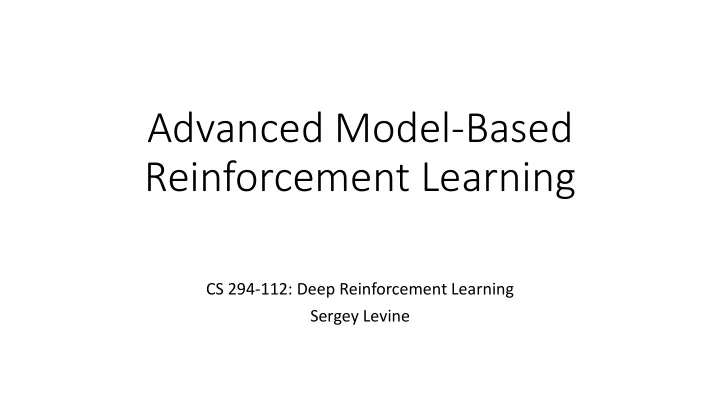

Advanced Model-Based Reinforcement Learning CS 294-112: Deep Reinforcement Learning Sergey Levine
Class Notes 1. Homework 3 is extended by one week, to Wednesday after next
Today’s Lecture 1. Managing overfitting in model-based RL • What’s the problem? • How do we represent uncertainty? 2. Model-based RL with images • The POMDP model for model-based RL • Learning encodings • Learning dynamics-aware encoding • Goals: • Understand the issue with overfitting and uncertainty in model-based RL • Understand how the POMDP model fits with model-based RL • Understand recent research on model-based RL with complex observations
A performance gap in model-based RL pure model-based model-free training (about 10 minutes real time) (about 10 days…) Nagabandi, Kahn, Fearing, L. ICRA 2018
Why the performance gap? …but still have high capacity over here need to not overfit here…
Why the performance gap? every N steps very tempting to go here…
Remember from last time…
Remember from last time…
Why are GPs so popular for model-based RL? expected reward under high-variance prediction is very low, even though mean is the same!
Intuition behind uncertainty-aware RL every N steps only take actions for which we think we’ll get high reward in expectation (w.r.t. uncertain dynamics) This avoids “exploiting” the model The model will then adapt and get better
There are a few caveats… Need to explore to get better Expected value is not the same as pessimistic value Expected value is not the same as optimistic value …but expected value is often a good start
How can we have uncertainty-aware models? Idea 1: use output entropy why is this not enough? Two types of uncertainty: aleatoric or statistical uncertainty epistemic or model uncertainty “the model is certain about the data, but we are not certain about the model” what is the variance here?
How can we have uncertainty-aware models? Idea 2: estimate mode uncertainty “the model is certain about the data, but we are not certain about the model” the entropy of this tells us the model uncertainty!
Quick overview of Bayesian neural networks expected weight uncertainty about the weight For more, see: Blundell et al., Weight Uncertainty in Neural Networks Gal et al., Concrete Dropout We’ll learn more about variational inference later!
Bootstrap ensembles Train multiple models and see if they agree! How to train? Main idea: need to generate “independent” datasets to get “independent” models
Bootstrap ensembles in deep learning This basically works Very crude approximation, because the number of models is usually small (< 10) Resampling with replacement is usually unnecessary, because SGD and random initialization usually makes the models sufficiently independent
How to plan with uncertainty distribution over deterministic models
Slightly more complex option: moment matching
Example: model-based RL with ensembles exceeds performance of model-free after 40k steps (about 10 minutes of real time) after before
Further readings • Deisenroth et al. PILCO: A Model-Based and Data-Efficient Approach to Policy Search. Recent papers: • Chua et al. Deep Reinforcement Learning in a Handful of Trials using Probabilistic Dynamics Models. • Feinberg et al. Model-Based Value Expansion for Efficient Model-Free Reinforcement Learning. • Buckman et al. Sample-Efficient Reinforcement Learning with Stochastic Ensemble Value Expansion.
Break
Previously: model-free RL with images This lecture : Can we use model-based methods with images? slides from C. Finn
Recap: Model-based RL What about POMDPs? slides from C. Finn
Learning in Latent Space Key idea : learn embedding , then learn in latent space (model-based or model-free) What do we want g to be? It depends on the method — we’ll see. slides from C. Finn
Learning in Latent Space Key idea : learn embedding , then learn in latent space (model-based or model-free ) controlling a slot-car slides from C. Finn
1. collect data with exploratory policy 2. learn low-dimensional embedding of image (how?) 3. run q-learning with function approximation with embedding } embedding is low-dimensional and summarizes the image slides from C. Finn
1. collect data with exploratory policy 2. learn low-dimensional embedding of image (how?) 3. run q-learning with function approximation with embedding Pros: + Learn visual skill very efficiently Cons: - Autoencoder might not recover the right representation - Not necessarily suitable for model-based methods slides from C. Finn
Learning in Latent Space Key idea : learn embedding , then learn in latent space ( model-based or model-free) slides from C. Finn
1. collect data with exploratory policy 2. learn smooth, structured embedding of image 3. learn local-linear model with embedding 4. run iLQG with local models to learn to reach goal image embedding is smooth and structured slides from C. Finn
1. collect data with exploratory policy 2. learn smooth, structured embedding of image 3. learn local-linear model with embedding 4. run iLQG with local models to learn to reach goal image Because we aren’t using states, we need a reward. slides from C. Finn
slides from C. Finn
Learning in Latent Space Key idea : learn embedding , then learn in latent space ( model-based or model-free) slides from C. Finn
1. collect data 2. learn embedding of image & dynamics model ( jointly ) 3. run iLQG to learn to reach image of goal embedding that can be modeled slides from C. Finn
slides from C. Finn
Local models with images
Learn directly in observation space Key idea : learn embedding Finn, L. Deep Visual Foresight for Planning Robot Motion. ICRA 2017. Ebert, Finn, Lee, L. Self-Supervised Visual Planning with Temporal Skip Connections. CoRL 2017.
Use predictions to complete tasks Designated Pixel Goal Pixel
Task execution
Predict alternative quantities If I take a set of actions: Pinto et al. ‘16 Will I collide? Dosovitskiy & Koltun ‘17 Kahn et al. ‘17 Will I successfully grasp? What will health/damage/etc. be? Pros: + Only predict task-relevant quantities! Cons: - Need to manually pick quantities, must be able to directly observe them
Recommend
More recommend